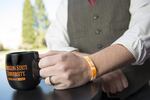
In an OSU experiment, rubber wristbands absorbed almost 50 chemical compounds, including pesticides, caffeine and pollution.
Stephen Ward / Oregon State University
Just when I thought the fashion of brightly-colored bracelets was waning as quickly as favor for disgraced cyclist Lance Armstrong, Oregon State University scientists could be bringing them back in style.
No, it's not because people with big brains are suddenly hijacking haute couture. The shifting fortunes of silicone wristbands comes after a study published recently in Environmental Science and Technologies showed the bracelets can soak up environmental chemicals people are exposed to daily.
OSU's Kim Anderson led the project, which asked subjects to wear specially designed silicone bracelets for 30 days. What the team found was surprising: People were exposed to nearly 50 different types of chemicals during the experiment.
Many of those chemicals were relatively harmless fragrances and oils found in cosmetics and soaps (along with a healthy dose of caffeine and nicotine). But they also found a mix of polycyclic aromatic hydrocarbons, which aren’t always as friendly.
PAHs are carbon chains that occur in oil, tar and burning fuel sources. Studies have shown that exposure to some types of PAHs come with a litany of health risks, ranging from cancer to birth defects.
OSU scientist Kim Anderson discovered common silicone
wristbands absorb chemicals from air, water and food.
Credit: Stephen Ward/Oregon State University
As dire as that sounds, the OSU study is actually pretty good news. It shows that airborne chemical monitoring can be cheap and much easier than currently available methods. As Scientific American reports:
“Anderson said the bracelets are a big step up from stationary air monitors, which only capture a snapshot in time and may not be near people. Measuring individuals' exposures usually means monitors worn in backpacks, which are difficult to use and expensive.”
More testing with the bracelets is already underway in New York, focusing on pregnant mothers in their final trimester. After the children are born, researchers plan to look at the effects of chemicals on birth defects and disease. Pesticide studies with the wristbands are also being conducted in West Africa.
Now, I know you're asking, "Can I slap on my old Livestrong wristband and find out if I'm going to get sick from swimming in the Willamette?" If you don't have access to laboratory-grade solvents, the answer is no.
The wristbands OSU used had to go through a long process of cleaning and treatment before they could accurately record chemical exposure. But as the Democrat Herald reports, they're working on speeding up that process so they'll be more widely available.
If OSU can make the technology mass producible, the possibilities to examine chemical exposure for particular communities or occupations are likely significant.

